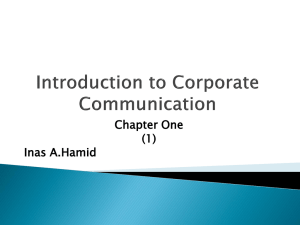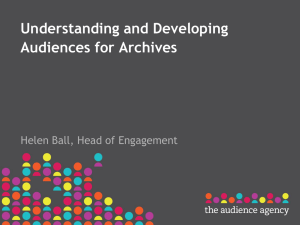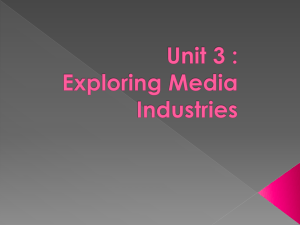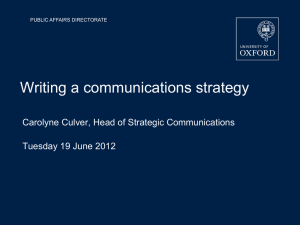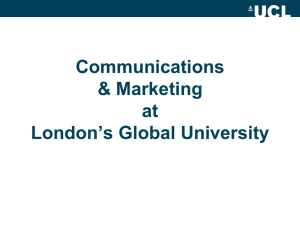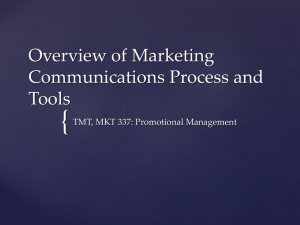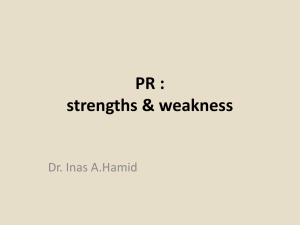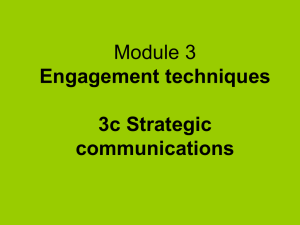Abstract art PowerPoint slide
advertisement
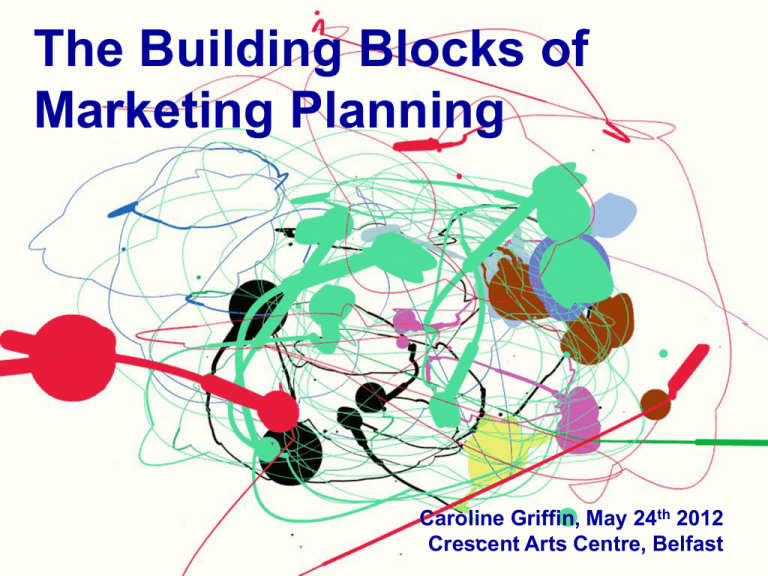
The Building Blocks of Marketing Planning Caroline Griffin, May 24th 2012 Crescent Arts Centre, Belfast What is marketing? A thinking and planning process which makes sure you spend your time and money on the right tasks to achieve your objectives. The management process responsible for identifying and satisfying customer requirements profitably (CIM – Chartered Institute of Marketers) Do a swap? The core concern of marketing is finding and using the links between organisation and customer to bring about a swap. The organisation’s: • capabilities • offerings • products Potential customers’: • needs • wants • desires Marketing mediates between provider and user and therefore needs to understand the needs and motivations of each and balance them. Marketing the arts We believe art should drive our activity, not audiences The artist has a right to fail – and we expect the audience to pay for this We pursue artistic excellence – not popular approval We need to be responsive to the changeable priorities of funders We can be dismissive of audiences We think our work should be of interest to everyone We don’t like to stereotype our audiences We have limited resources Why plan? Benefits for communications to form relationships with existing and potential audiences gain and retain more customers find the best ways to communicate with them to convey clear and consistent messages Benefits for organisation to stay focused on your objectives to make the best use of your resources stand out in a competitive marketplace adapt to change to evaluate your success Relationship marketing Relationship marketing focuses on customer retention and satisfaction, rather than the 'quick win' of securing an individual transaction. Relationship marketing differs from other forms of marketing in that it recognises the long term value of keeping customers, and aims to minimise churn by devising marketing strategies to retain existing clients as well as to attract new ones. A key concept in relationship marketing is the 'lifetime value' of an individual customer Four stages of marketing planning Marketing Planning Phase Phase 1 Goal Setting Phase 2 Situational Analysis Phase 3 Choosing Strategies Phase 4 Taking Action Ask Yourself . . . ? Activities Where do we want to go? Where are we now? How do we get there? How can we implement these plans? Establish Organisational Mission Set Marketing Objectives Internal Analysis External Analysis SWOT Audience and product analysis Overall approaches Branding Marketing Mix Evaluation Vision and mission Who are you? What do you exist to acheive? What is distinctive about your organisation? What aspirations does the whole team share? What are you passionate about? Setting objectives Specific The goal is clear and unambiguous; without vagaries and platitudes. Measureable The goal stresses the need for concrete criteria for measuring progress. Attainable The goal may be challenging isn’t out of reach. Relevant The goal must matter. Timetabled Goals need grounding within a time frame, with a delivery date. What’s happening in your organisation? Organisational audit Ambition Goals Capacity and resources Environmental review PEST analysis Competitor analysis Futurescoping Your existing marketing Marketing audit Internal Data resources External data Impact of previous activities Market segments What is a marketing segment? “A market segment consists of a group of customers or consumers who share the same or similar needs” Malcolm MacDonald, Marketing Plans, 1984 OR “A group of actual or potential customers who can be expected to respond in approximately the same way to a given offer” Identifying market segments Demographic Approach age social grade life stage Geographical Approach Behavioural Approach Attitudinal Approach family circumstance place where people live place where people work what people have done in the past, e.g. attendance at galleries, previous purchases, other events attended personal values lifestyle values beliefs Using evidence Data is at the heart of what we do Data distinguishes the marketers opinions about people Information underpins our planning We can test not guess Everything is measurable Transparency Data sources Internal Your mailing list Audiences postcode data Behavioural data Research on your audiences Profiles External National statistics Mosaic/Acorn profiles Arts Audiences: Insight Research studies What is marketing strategy? A strategy is a systematic plan for action to help an organisation reach it's long-term goals. A strategy addresses over-arching issues and considers all relevant factors. It is measurable and is developed using appropriate and accurate data. We set strategy we consider the relationship between: our audiences our products or activities, Particularly with regard to whether they are: familiar unfamiliar. Determining strategy Strategy: More of the same Are you working with existing audiences and is the product something the organisation is familiar with? Sustaining and growing the work and approaches we are used to, e.g. maximising income streams, forging deeper relationships with clients Strategy: Developing the market Do you want to attract new audiences to your existing offer? Engaging more and different people to the work that we do, e.g. making relationships with new people, demystifying products, developing your welcome. Strategy: Developing the product Do you want to try something new that you think your core audiences might be interested in? Encouraging existing audiences to try something new, e.g. providing incentives, providing detailed information, talking to people. The marketing mix Product – the physical characteristics Price – affordable, pricing for status Place – opening times, transport etc. Promotion – means of communicating People – sales staff, interpreting the product Processes – enhancing the customer experience, mechanisms for delivery Physical evidence – tangible aspects of the whole experience Why audiences don’t come “It’s too expensive” means “I don’t have the time” means “I don’t see the value” “I can’t commit to doing it all” “It’s boring” means “It makes me feel stupid” “My kids don’t like art” means “It doesn’t engage my kids, and if they suffer, I suffer!” “I just don’t think about it” means “It’s not relevant to my life!” “It’s difficult to find parking” “I don’t need one more means complication in my life” Taken from presentation by Arthur Cohen from LaPlacha Cohen, laplachacohen.com Features and benefits Features are: Descriptive, practical and tangible Descriptive of the qualities that are inherent in the product Benefits are: Evocative, personal and intangible Descriptive of the consumer’s experience Identifying benefits Feature Benefit this CD player has 16-bit four-fold oversampling The sound is clearer, crisper and more rounded Apply the . . .which means that . . . test Taken from Morton Smyth: Messages & Benefits Seminar Monitoring and evaluation Identify how you will collect information to monitor targets Ensure you monitor and record your organisational processes and experiences Set a time and process for review Include others Key features of a successful marketing plan It looks to the future – is the audiences sustainable? It’s integrated into the organisation’s business plan The plan considers every element of the customer experience It’s data-led and evidence-based It demonstrates how it addresses audience needs It doesn’t have to cost a lot or use a lot of resources, as long as it is well-considered It must be measurable and measured Caroline Griffin Consultant: Coach: Mentor Contact: e: caroline@carolinegriffin.com, t: 07787505166 WWW.CAROLINEGRIFFIN.COM

